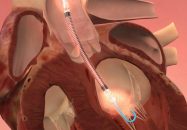Severe tricuspid regurgitation (TR) presents a reserved prognosis when not treated in time, seeing as systemic venous congestion might significantly limit quality of life in these patients. For many years it was thought diuretic therapy was the only option to treat these patients, since the surgical alternative offered suboptimal results and many patients were deemed…
Can Ultrasound Treat Aortic Stenosis?
Severe calcified aortic stenosis is a common condition that can currently be effectively treated with SAVR or TAVR. However, some patients, given comorbidities or anatomical characteristics, are not good candidates for these therapeutic alternatives. The non-invasive ultrasound therapy (NIUT) has surged as viable alternative. It claims ultrasound might act on calcified valves, and mobilize tissue…
Is AS Only Important When Severe?
Aortic stenosis (AS) is a progressive disease associated with morbidity and mortality, especially in severe cases. However, recent studies have revealed that moderate stenosis can also have unfavorable consequences in the course of the disease. One of the challenges lies in that determining its severity is sometimes difficult due to discrepancies between valve area, gradient,…
Low Gradient, Normal Flow Aortic Stenosis: Changes in Quality of Life with TAVR
There is no question as regards the recommended treatment for symptomatic severe aortic stenosis, seeing as both transcatheter and surgical aortic valve replacement (TAVR and SAVR) have shown to significantly improve prognosis. This is despite the fact that there is still certain ambiguity around its characterization, which looks to define it according to hemodynamic severity…
CAPTIS, a Novel Cerebral Embolic Protection System in TAVR
The incidence of stroke after TAVR ranges between 2 and 5%, depending on the series, which has been associated with higher morbimortality, affecting patient quality of life and their psycho-social environment. Many cerebral embolic protection systems have been developed in response, and even though they have been shown beneficial in many studies, their role in…
Cerebral Embolic Protection Devices: How Useful are they in TAVR?
During TAVR, we often fear the possibility of a stroke, which occurs in approximately 1 – 2% of cases. In general, this phenomenon is caused by thrombi stemming from atherosclerotic or calcified plaque, depending on the etiology. Even though its incidence has declined with technology development and the increasing expertise of operators, it is still…
Is TAVR Beneficial in Cardiogenic Shock?
The presence of cardiogenic shock (CS) in a setting of aortic stenosis ranges from 1% to 4%. The prognosis for this scenario is ominous due to subendocardial ischemia, which presents as a decrease in ventricular preload and an increase in afterload. Aortic valvuloplasty has been used in this context, but, unfortunately, it has been associated…
Acute Pulmonary Thromboembolism: When Anticoagulation Alone May Not Be Enough
In recent times, pulmonary thromboembolism (PTE) has been the subject of growing research due to its persistent impact on morbidity and mortality. Acute PTE, if not properly treated or inadequately treated, can lead to a debilitating condition known as post-PTE syndrome, which has been documented in nearly 50% of survivors. The primary treatment strategy for…
Impella in High Risk Coronary Angioplasty before TAVR
The population is aging, which is closely related with the presence of aortic stenosis. This condition, as we know, is associated with coronary artery disease (CAD) approximately in 50% of cases. In high risk surgical patients, this calls for procedures such as percutaneous coronary intervention (PCI) and transcatheter aortic valve replacement (TAVR). PCI with ventricular…
TCT 2023 | CLASP IID Study 1-Year Results: PASCAL vs. MITRACLIP for Degenerative Mitral Regurgitation
The negative impact of mitral regurgitation (MR) on patient mortality, morbidity, and quality of life is widely recognized. However, only 15% of patients are referred for surgery due to their high surgical risk and low ejection fraction. Transcatheter edge-to-edge repair has become an important alternative for this group of patients. For subjects with degenerative MR,…
TCT 2023 | VIVA Trial: TAVR vs. SAVR in Patients with Severe Aortic Stenosis and Small Aortic Annulus
Degenerative aortic stenosis (AS) is the most common valve condition. A significant number of AS patients presents a small aortic annulus (SAA), especially women. Treating this group of patients remains challenging, seeing as they have a high incidence of suboptimal hemodynamic results. Despite the development of TAVR (transcatheter aortic valve replacement), the current guidelines do…









